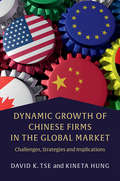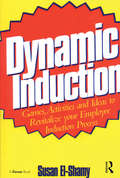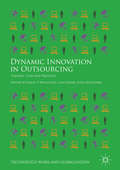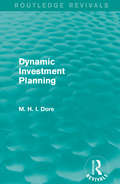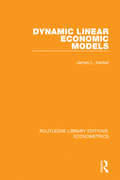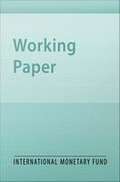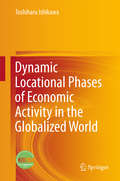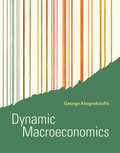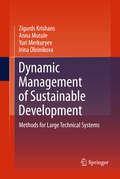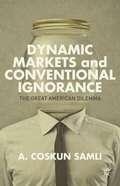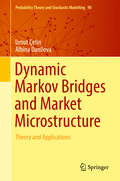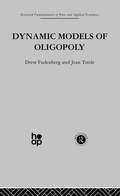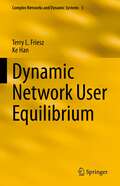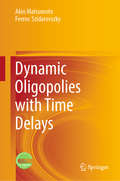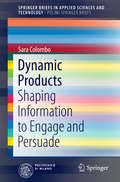- Table View
- List View
Dynamic Factor Price Equalization & International Income Convergence
by Clinton R. Shiells Joseph FrancoisA report from the International Monetary Fund.
Dynamic Faith Journal
by Jerry FalwellEach day will be a 2-page spread with a summary statement and applications taken from Building Dynamic Faith. Daily guide for the reader to apply Building Dynamic Faith. Includes all of the application exercises from Building Dynamic Faith with room to journal.
Dynamic Formal Epistemology
by Olivier Roy Patrick Girard Mathieu MarionThis volume is a collation of original contributions from the key actors of a new trend in the contemporary theory of knowledge and belief, that we call "dynamic epistemology". It brings the works of these researchers under a single umbrella by highlighting the coherence of their current themes, and by establishing connections between topics that, up until now, have been investigated independently. It also illustrates how the new analytical toolbox unveils questions about the theory of knowledge, belief, preference, action, and rationality, in a number of central axes in dynamic epistemology: temporal, social, probabilistic and even deontic dynamics.
Dynamic Games in Economics
by Vladimir M. Veliov Josef Haunschmied Stefan WrzaczekDynamic game theory serves the purpose of including strategic interaction in decision making and is therefore often applied to economic problems. This book presents the state-of-the-art and directions for future research in dynamic game theory related to economics. It was initiated by contributors to the 12th Viennese Workshop on Optimal Control, Dynamic Games and Nonlinear Dynamics and combines a selection of papers from the workshop with invited papers of high quality.
Dynamic Growth of Chinese Firms in the Global Market: Challenges, Strategies and Implications
by David K. Tse Kineta HungHow have Chinese multinationals benefited from China's economic boom to enable their international expansion? This book is based on many years of original research tracing the emergence, growth and future of Chinese firms in the world economy. The authors seek to provide new perspectives and insights for business executives and graduate students through a comprehensive study of how China's firms globalize and operate, and the implications of this for economic success. Based on detailed case studies and summative examples of successful Chinese firms, Tse and Hung point out their strengths (e.g. making innovations affordable to many developing nations), their weaknesses (products made in China are not highly regarded) and their mistakes (being insensitive to host economy needs and at times corruptive acts). They argue that the world economy would benefit from engaging with Chinese and other emerging economy firms to learn from the strategies they employ to achieve their global reach.
Dynamic Induction: Games, Activities and Ideas to Revitalize your Employee Induction Process
by Susan El-ShamyDynamic Induction: Games, Activities and Ideas to Revitalise Your Employee Induction Process is a practical guide to upgrading your induction process and actively facilitating the new employee's becoming a positive, productive member of the organization as quickly as possible. This informative, straightforward book has been designed to make it simple for you to take action and repair, revitalize or even rebuild your entire new-employee orientation and assimilation procedure into a dynamic and engaging process that will improve communication, co-operation and group cohesiveness. Using a series of assessments, quizzes, charts and checklists, this instructive handbook presents more than 200 ideas and suggestions for enhancing and energizing your complete induction process, starting from the moment a new employee accepts the job. Dynamic Induction also provides you with 50 games and structured activities that can be used to impart work-related information to staff embarking on a new job. These games and activities can be used in all of the instruction-related aspects of your induction process, including planned actions taken to welcome and help the new person as well as specific learning events designed to accelerate the integration of the new employee into the workforce.
Dynamic Innovation in Outsourcing: Theories, Cases And Practices (Technology, Work And Globalization Ser.)
by Julia Kotlarsky Ilan Oshri Leslie P. WillcocksThis book is a guide for achieving innovation through outsourcing. Unpacking the various challenges faced by client firms and suppliers, the authors take the reader through the innovation lifecycle and devise a clear plan to achieve valuable results. Offering practical frameworks and tools to ensure informed decision-making at every stage, this book also includes collaborative structures and metrics to measure outcomes. Written by leading figures in the area of outsourcing, this book offers both the academic rigor and the hands-on experience based on dozens of cases that walk the reader from the very beginning of the outsourcing journey to the successful delivery of transformative innovations.
Dynamic Investment Planning (Routledge Revivals)
by Mohammed H. DoreIn dynamic investment planning the time of investment is a significant issue. By simplifying the mathematical notation, the author of this book seeks to make control theory a practical tool that can be applied to the problem of timing. The book, first published in 1977, begins with an introduction to one important approach to control theory – dynamic programming. Then some of the relevant literature that deals with investment decision-making is reviewed. This is followed by a mathematically formulated planning model. The computational aspects of the model are discussed and a complete computer flow chart is given. The second part of the book gives a thorough application of the theory by means of a detailed case study – the planning of a steel industry. The case study illustrates how a fairly abstract dynamic analysis can be effectively integrated with practical decision-making concerns. This book is ideal for students of economics and business.
Dynamic Linear Economic Models (Routledge Library Editions: Econometrics #10)
by James L. KenkelOriginally published in 1974. This book provides a rigorous and detailed introductory treatment of the theory of difference equations and their applications in the construction and analysis of dynamic economic models. It explains the theory of linear difference equations and various types of dynamic economic models are then analysed. Including plenty of examples of application throughout the text, it will be of use to those working in macroeconomics and econometrics.
Dynamic Loan Loss Provisions in Uruguay: Properties, Shock Absorption Capacity and Simulations Using Alternative Formulas
by Torsten WezelA report from the International Monetary Fund.
Dynamic Locational Phases of Economic Activity in the Globalized World
by Toshiharu IshikawaThis book clarifies the mechanisms of economicglobalization in changing industries' locations and shows how industries' locations have changedthrough those mechanisms. First, the book deals with the retailing industry. Introducing the concept of a contactprice into the market area analysis, it is shown in Part I that retailers'market areas and prices are changed in different ways by a reduction oftransportation costs. The mechanism of these changes is explained by checkingthe contact prices at apexes of the retailers' market areas. Then the book movesto the manufacturing industry and deals with a firm's production process. Part IIof the book shows the manner in which the production volume of factories withinan agglomeration is decreased as the number of factories within theagglomeration increases. Subsequently, considering the fact that many productionfactories depart from agglomerations to other sites to reduce production costs,a method of searching for a factory's new site is proposed in which a firm can seekout an optimal location of a factory in a short period of time. By referring toa chaotic phenomenon, a firm sets a locationprospective area in a large geographical area and selects an optimallocation within that area. In the third part of the book the city system is thefocus. Part III elucidates the theoretical formation of a city system andanalyzes structural changes of a city system due to a reduction oftransportation costs. The mechanism of the change is explained by a flexible market area theory which studiesa city system by using the market areas established in the free-entry equilibrium. Then, the economic relationships between the cities within a city system areexamined from the point of view of the land rent in the cities' areas. Thisanalysis shows the influences of a change in the largest city on other cities. Finally,the relationships between a city system and regional performance are examinedusing real data. The examination shows that the city system reveals the regionalperformance.
Dynamic Macroeconomics (The\mit Press Ser.)
by George AlogoskoufisAn advanced treatment of modern macroeconomics, presented through a sequence of dynamic equilibrium models, with discussion of the implications for monetary and fiscal policy.This textbook offers an advanced treatment of modern macroeconomics, presented through a sequence of dynamic general equilibrium models based on intertemporal optimization on the part of economic agents. The book treats macroeconomics as applied and policy-oriented general equilibrium analysis, examining a number of models, each of which is suitable for investigating specific issues but may be unsuitable for others.After presenting a brief survey of the evolution of macroeconomics and the key facts about long-run economic growth and aggregate fluctuations, the book introduces the main elements of the intertemporal approach through a series of two-period competitive general equilibrium models—the simplest possible intertemporal models. This sets the stage for the remainder of the book, which presents models of economic growth, aggregate fluctuations, and monetary and fiscal policy. The text focuses on a full analysis of a limited number of key intertemporal models, which are stripped down to essentials so that students can focus on the dynamic properties of the models. Exercises encourage students to try their hands at solving versions of the dynamic models that define modern macroeconomics. Appendixes review the main mathematical techniques needed to analyze optimizing dynamic macroeconomic models. The book is suitable for advanced undergraduate and graduate students who have some knowledge of economic theory and mathematics for economists.
Dynamic Management of Sustainable Development
by Irina Oleinikova Anna Mutule Yuri Merkuryev Zigurds KrishansDynamic management of systems development is a precondition for the realization of sustainable system development. This approach allows for the usage of systems theory methods that take into consideration the interaction of decisions made over time and space. A characteristic feature of this kind of method is that the process of sophisticated object development over time is examined for optimal decision selection. This requires the application of modelling methods that represent properties of the developing objects, high speed calculation methods for the estimation of technical and economic characteristics, as well as effective optimization methods. Dynamic Management of Sustainable Development presents a concise summary of the authors' research in the area of dynamic methods analysis of technical systems development. Along with systematic illustration of mathematical methods, considerable attention is drawn to practical realization and applications. Dynamic Management of Sustainable Development will be helpful for scientists involved in the mathematical modelling of large technical systems development and for engineers working in the area of large technical systems planning.
Dynamic Markets and Conventional Ignorance
by A. Coskun SamliA market economy is the only mechanism that can create jobs, distribute wealth, spur economic growth, and stabilize the economy for all. However, the current American market economy is not working - it is helping the "1%" instead of distributing wealth and yet simultaneously convincing the "99%" that this market is the only way to create jobs. The current unchecked system allows those wealthy few to "steal the American dream," as Hedrick Smith claimed. In order for the United States to grow the economy, the current system must first be modified to level the playing field, and then must be used to develop the market system's originally intended purpose: improving the quality of life for all. In this follow up to From a Market Economy to a Finance Economy, Samli reflects on his more than half a century of economic experience and research, maintaining that financiers, the government, and many decision makers in both politics and the economy, do not really support the "free market. " He puts forth key ideas for using the market mechanism correctly to benefit all Americans.
Dynamic Markov Bridges and Market Microstructure: Theory And Application (Probability Theory and Stochastic Modelling #90)
by Umut Çetin Albina DanilovaThis book undertakes a detailed construction of Dynamic Markov Bridges using a combination of theory and real-world applications to drive home important concepts and methodologies. In Part I, theory is developed using tools from stochastic filtering, partial differential equations, Markov processes, and their interplay. Part II is devoted to the applications of the theory developed in Part I to asymmetric information models among financial agents, which include a strategic risk-neutral insider who possesses a private signal concerning the future value of the traded asset, non-strategic noise traders, and competitive risk-neutral market makers. A thorough analysis of optimality conditions for risk-neutral insiders is provided and the implications on equilibrium of non-Gaussian extensions are discussed.A Markov bridge, first considered by Paul Lévy in the context of Brownian motion, is a mathematical system that undergoes changes in value from one state to another when the initial and final states are fixed. Markov bridges have many applications as stochastic models of real-world processes, especially within the areas of Economics and Finance. The construction of a Dynamic Markov Bridge, a useful extension of Markov bridge theory, addresses several important questions concerning how financial markets function, among them: how the presence of an insider trader impacts market efficiency; how insider trading on financial markets can be detected; how information assimilates in market prices; and the optimal pricing policy of a particular market maker.Principles in this book will appeal to probabilists, statisticians, economists, researchers, and graduate students interested in Markov bridges and market microstructure theory.
Dynamic Modeling and Applications for Global Economic Analysis
by Elena I. Ianchovichina Terrie L. WalmsleyA sequel to Global Trade Analysis: Modeling and Applications (Cambridge University Press, 1996, edited by Thomas W. Hertel), this new volume presents the technical aspects of the Global Trade Analysis Program's global dynamic framework (GDyn) and its applications within important global policy issues. The book covers a diverse set of topics including trade reform, growth, investment, technology, demographic change, and the environment. Environmental issues are particularly well-suited for analysis with GDyn, and this volume covers its uses with climate change, resource use, and technological progress in agriculture. Other applications presented in the book focus on integration issues such as rules governing foreign investment, e-commerce regulations, trade in services, harmonization of technical standards, sanitary and photo-sanitary regulations, streamlining of customs procedures, and demographic change and migration.
Dynamic Modeling, Empirical Macroeconomics, and Finance
by Lucas Bernard Unurjargal NyambuuThis edited volume, with contributions by area experts, offers discussions on a range of evolving topics in economics and social development. At center are important issues central to sustainable development, economic growth, technological change, the economics of climate change, commodity markets, long wave theory, non-linear dynamic models, and boom-bust cycles. This is an excellent reference for academic and professional economists interested in emerging areas of empirical macroeconomics and finance. For policy makers and curious readers alike, it is also an outstanding introduction to the economic thinking of those who seek a holistic and all-compassing approach in economic theory and policy. Looking into new data and methodology, this book offers fresh approaches in a post-crisis environment. Set in a profound understanding of the diverse currents within the many traditions of economic thought, this book pushes the established frontiers of economic thinking. It is dedicated to a leading scholar in the areas covered in this book, Willi Semmler.
Dynamic Models and Inequality: The Role of the Market Mechanism in Economic Distribution (Contributions to Economics)
by Robin MaialehThis book examines empirical and theoretical research on economic inequality from the perspective of dynamic models. By using advanced mathematical tools, it reveals fundamental market dynamics and underlines the role of subsistence constraints and competition in economic distribution.
Dynamic Models for Volatility and Heavy Tails
by Andrew C. HarveyThe volatility of financial returns changes over time and, for the last thirty years, Generalized Autoregressive Conditional Heteroscedasticity (GARCH) models have provided the principal means of analyzing, modeling, and monitoring such changes. Taking into account that financial returns typically exhibit heavy tails - that is, extreme values can occur from time to time - Andrew Harvey's new book shows how a small but radical change in the way GARCH models are formulated leads to a resolution of many of the theoretical problems inherent in the statistical theory. The approach can also be applied to other aspects of volatility, such as those arising from data on the range of returns and the time between trades. Furthermore, the more general class of Dynamic Conditional Score models extends to robust modeling of outliers in the levels of time series and to the treatment of time-varying relationships. As such, there are applications not only to financial data but also to macroeconomic time series and to time series in other disciplines. The statistical theory draws on basic principles of maximum likelihood estimation and, by doing so, leads to an elegant and unified treatment of nonlinear time-series modeling. The practical value of the proposed models is illustrated by fitting them to real data sets.
Dynamic Models of Oligopoly (Fundamentals Of Pure And Applied Economics Ser. #Vol. 1)
by D. Fudenberg J. TiroleFudenberg and Tirole use the game-theoretic issues of information, commitment and timing to provide a realistic approach to oligopoly.
Dynamic Negotiation: Seven Propositions About Complex Negotiations
by Michael D. WatkinsChallenges conventionally held views of negotiations, arguing that they are simplistic, static, and sterile. Develops seven propositions about real-world negotiations emphasizing the impact of complexity and the need for learning and adaption.
Dynamic Network User Equilibrium (Complex Networks and Dynamic Systems #5)
by Terry L. Friesz Ke HanThis book presents advanced research in a relatively new field of scholarly inquiry that is usually referred to as dynamic network user equilibrium, now almost universally abbreviated as DUE. It provides the first synthesis of results obtained over the last decade from applying the differential variational inequality (DVI) formalism to study the DUE problem. In particular, it explores the intimately related problem of dynamic network loading, which determines the arc flows and effective travel delays (or generalized travel costs) arising from the expression of departure rates at the origins of commuter trips between the workplace and home. In particular, the authors show that dynamic network loading with spillback of queues into upstream arcs may be formulated as a differential algebraic equation system. They demonstrate how the dynamic network loading problem and the dynamic traffic user equilibrium problem may be solved simultaneously rather than sequentially, as well as how the first-in-first-out queue discipline may be maintained for each when Lighthill-Whitham-Richardson traffic flow theory is used. A number of recent and new extensions of the DVI-based theory of DUE and corresponding examples are presented and discussed. Relevant mathematical background material is provided to make the book as accessible as possible.
Dynamic Oligopolies with Time Delays
by Ferenc Szidarovszky Akio MatsumotoThis is the first book to comprehensively examine the asymptotic behavior of dynamic monopolies, duopolies, and oligopolies where firms face information and implementation delays. It considers discrete and continuous timescales, continuously distributed delays, as well as single and multiple delays. It also discusses models with linear and hyperbolic price functions in three types of oligopolies: Cournot competition with quantity-adjusting firms, Bertrand competition with price-adjusting firms, and mixed oligopolies with both types of firms. In addition to the traditional Cournot-Nash equilibria, it introduces cases of partial cooperation are also introduced, leading to the analysis of cartelizing groups of firms and possible governmental actions against antitrust behavior. Further, the book investigates special processes for firms learning about the uncertain price function based on repeated market information. It addresses asymptotic properties of the associated dynamic systems, derives stability conditions, identifies stability switching curves, and presents in global analyses of cases of instability. The book includes both theoretical results and computer studies to illustrate and verify the theoretical findings.
Dynamic Optimization in Environmental Economics
by Willi Semmler Elke Moser Gernot Tragler Vladimir M. VeliovThe book presents new developments in the dynamic modeling and optimization methods in environmental economics and provides a huge range of applications dealing with the economics of natural resources, the impacts of climate change and of environmental pollution, and respective policy measures. The interrelationship between economic activities and environmental quality, the development of cleaner technologies, the switch from fossil to renewable resources and the proper use of policy instruments play an important role along the path towards a sustainable future. Biological, physical and economic processes are naturally involved in the subject, and postulate the main modelling, simulation and decision-making tools: the methods of dynamic optimization and dynamic games.
Dynamic Products
by Sara ColomboThis book explores how dynamic changes in products' sensory features can be used to convey information to the user in an effective and engaging way. The aim is to supply the reader with a clear understanding of an important emerging area of research and practice in product design, referred to as dynamic products, which is opening up new possibilities for the integration of product design with digital and smart technologies and offering an alternative to the use of digital interfaces. Dynamic products are artifacts displaying sensory characteristics - visual, tactile, auditory, or olfactory - that change in a proactive and reversible way over time, addressing one or more of the user's senses. The reader will learn why and how to communicate by means of such dynamic products. Their potential advantages and limitations are identified and design tools are proposed to support the design activity. It is hoped that the book will stimulate the design community to reflect upon the ever more compelling need to merge the virtual and the material in the information society by exploiting technological possibilities in order to create more meaningful and involving experiences.




